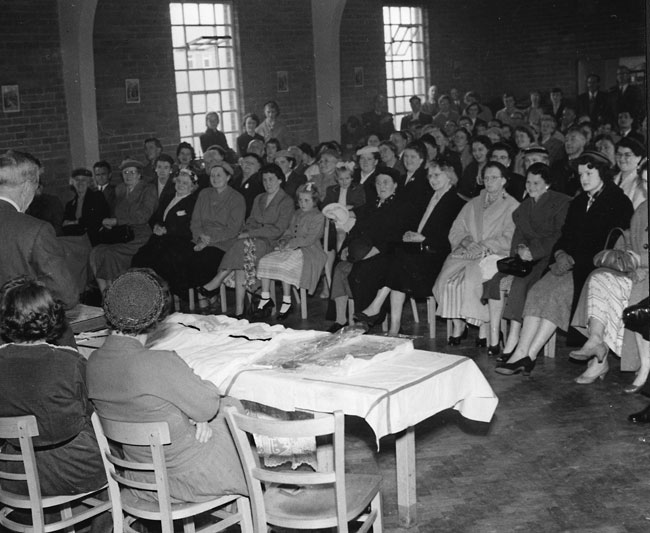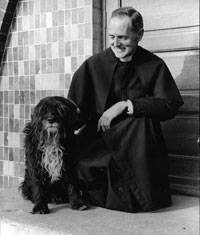


History of the Holy Name of Jesus
It is approximately 90 years since the idea of forming Holy Name Parish first came into the minds of the pioneers who were responsible for it’s establishment.


In fact it began as a war time expedient, because people who lived in the area had considerable difficulty in getting to Mass when the fuel restrictions began to bite hard as the second world war progressed.
A prominent catholic business man, Mr. Frank Moorhouse, approached Ind Coope, the brewery concern, and sought permission for Mass to be held at the Lawnswood Arms on Otley Road. It was not so much the upper room of an inn as the Winter Gardens of a smart suburban road house of the thirties; it served the congregations until these began to swell, as service men an women returned the war.
The curates from St. Anne’s Cathedral came to say Mass each Sunday at this strange chapel of ease; one of them, Fr, Herbert Backhouse, is still remembered by those early parishioners for his great help and interest.
Next two of the parishioners negotiated with the committee of Adel Community Centre, in new Adel Lane, whose wooden ex-airfield building they had helped to re-erect in the grounds of the Society of Friends. With the permission of the Friends – and with the proviso:
NO SINGING, PLEASE
Sunday Mass was held there for several years.
A small band of self-appointed amateur census-takers conducted a survey of the area, and found that there were many more Catholics than they had at first believed, and many children unbaptised and unconfirmed. A parish committee which had been formed took an option on three and a half acres of land which became available in Otley Old Road – the site of the present church. They made up their census findings in a brochure which they were able to present to Bishop Heenan almost immediately after he was appointed Bishop of Leeds.
His Lordship greeted the delegation, “ Before any of you speak, I want you to know that I do not know where Adel is. I do not know anything of the problems associated with the district, other than the information you have given me. I am grateful for the brochure about the Catholic community in the area, but, if you are asking me to sanction a major basilica in the three and a half acres, forget it! But the delegation – with Fr. Backhouse as promoter in the wings – responded, No, my Lord, all we want is a priest of our own, Within a month they got their priest, Fr. Thomas Power, who had just finished building the church in the parish of Kendray in Barnsley.

Fr. Power was installed in a semi in Spennithorpe Avenue and weekday Masses were said there, and the children were baptized there too. Sunday congregations still met at the Adel Community Centre for another two years. The initial support and encouragement given the parish by successive committees at the Centre remains today, and we shall always be grateful to them.
Money-raising began in earnest, led by Fr. Power and backed by an enthusiastic band of parishioners. The target for the church was £12,000, and aimed at it was a never-ending steam of efforts – bingo, raffles, whist-drives, dances, bazaars, garden parties etc. etc…… It’s very interesting to look through Fr. Power’s account book for this period. He arrived in September 1951, and the first offertory collection was £5.10.0. After eight months the offertory for the whole of this time was only £195.10.6.
But the cavalry had arrived in the form of the football Pool;
In this same period it produced a profit of £241.10.0. After a further twelve months, the total offertory collection for the year was £330, but the pool brought in £891. ‘Brought in’ is hardly the right word – only the original members and collectors will know how much work it meant. The fund raising had got off to a good start. There was £800 in the kitty from the early days. At the later interview at Bishop’s House Dr. Heenan had pushed across the table a cheque for £2,500, which he had up his Episcopal sleeve; this had been intended for a war memorial which never materialized. He had wished them luck, though it later became clear that he disapproved of ‘the grandiose plan’, as he put it, for the new Holy Name. Never the less, he cheerfully agreed to lay the foundation stone on February 7th 1953, a freezing day in Coronation Year; and he opened the new church, which could also be used as a hall, on November 4th of that same year.
The church was designed by Mr. Stephen Simpson, and was built by ‘Mary Harrison’, as he famous Leeds building firm was invariably called. Fr. Power took up the suggestion of one of the parishioners that the church be called the Holy Name.
This is an extract written for the Service of Consecration held 1 December 1979.
Click here to download a pdf written by Mike Casey, a former parishioner of the Holy Name, who recalls the pioneering work of those far sighted, dedicated and diligent Catholics whose dream of having a church of their own came true 55 years ago.
Priest dog suits the part

